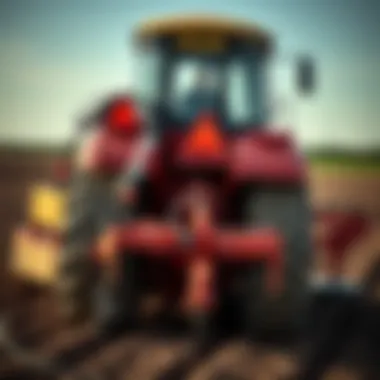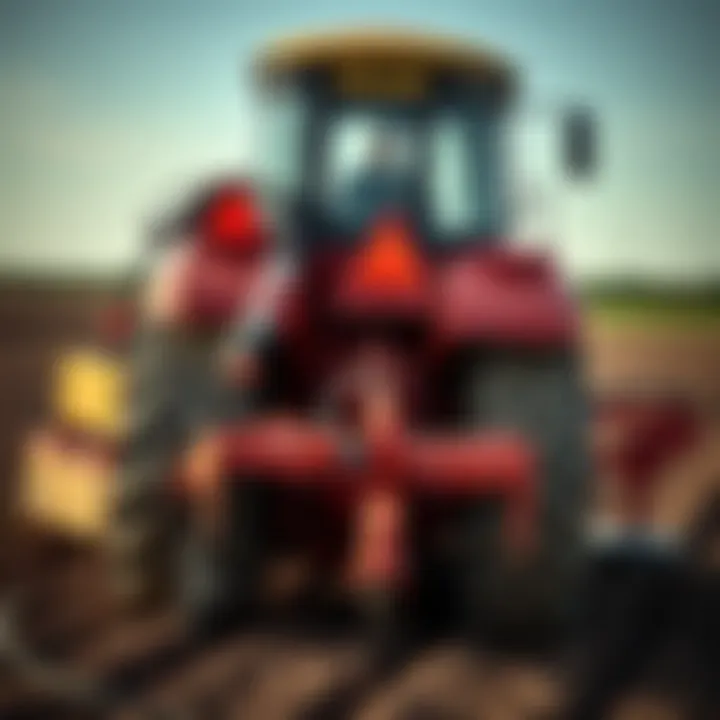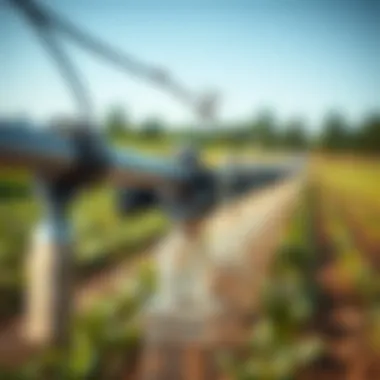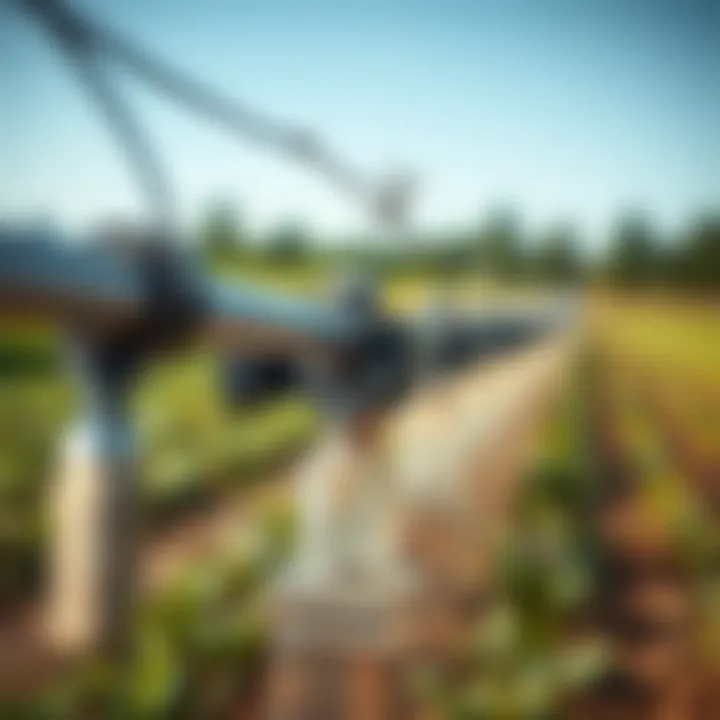Infield Maintenance Equipment in Agriculture and Horticulture


Intro
Maintaining the health of crops and plants is no small task. The success that farmers and horticulturists achieve often hinges on the precise handling of a variety of tasks, from soil preparation to routine upkeep. Infield maintenance equipment plays a pivotal role in this process, acting as the backbone of agricultural operations. This article aims to shine a light on the world of infield maintenance equipment, exploring its diverse forms, functions, and the essential maintenance practices that keep these tools in optimal condition.
By understanding the technical aspects and innovations within this field, professionals and enthusiasts alike can better appreciate how the right equipment can lead to more sustainable and efficient farming practices. So, let’s dive into what infield maintenance equipment is all about, how its history intertwines with modern advancements, and why proper utilization can make a world of difference in agriculture and horticulture.
Topic Overview
Definition and Importance
Infield maintenance equipment encompasses a broad range of tools designed to enhance the quality and productivity of agricultural fields and horticultural endeavors. This includes everything from tractors and tillers to sprayers and aerators. These tools are not merely luxury items; rather, they are fundamentally important for ensuring that crops receive the care they require. Having the right equipment enables farmers to:
- Work efficiently
- Save time
- Optimize crop yield
- Promote soil health
Thus, understanding the various pieces and their specific roles can significantly affect the output and quality of agricultural products.
Brief History and Evolution
Historically, farming equipment has undergone tremendous changes from simple hand tools used in ancient times to the highly specialized machines we see today. For instance, the advent of the tractor in the late 19th century marked a revolutionary point in agriculture, significantly altering traditional farming methods. Over the decades, advancements in technology have led to sophisticated machinery that integrates computer systems for precision farming.
Today, equipment isn't just about brute force; it's about smart solutions that accommodate sustainability and efficiency. Mechanized equipment now often features GPS technology, which allows farmers to monitor their land remotely, ensuring that they can manage their resources more effectively.
Key Techniques and Innovations
Sustainable Farming Practices
Sustainability in agriculture has gained momentum over the years. Farmers are now increasingly adopting practices that minimize environmental impact while enhancing productivity. For example:
- Cover cropping helps to protect and enrich soil.
- Crop rotation improves soil health and reduces pest pressure.
- Integrated pest management (IPM) minimizes chemical use and encourages biodiversity.
By integrating sustainable practices with advanced infield maintenance equipment, farmers can generate higher yields while reducing their carbon footprint.
Advanced Agronomic Technologies
With technology marching forward, today’s infield maintenance equipment is smarter than ever. Innovations such as precision agriculture embed various technologies in machinery that collects and analyzes data, allowing farmers to:
- Monitor soil moisture and nutrient levels
- Apply fertilizers only where needed
- Customize care for different crop sections
Moreover, using drones to survey fields is becoming a common approach to gather data, helping farm operations to make informed decisions
Practical Applications
Step-by-Step Guides
To get the most out of infield maintenance equipment, farmers can follow tailored guides for their specific tasks. Here’s a brief outline on how to maintain a tractor:
- Regular Inspections: Check oil levels, inspect tires, and look for any leaks.
- Cleaning: Remove any debris and clean air filters regularly.
- Lubrication: Ensure that all moving parts are well-lubricated to avoid wear and tear.
- Battery Care: Keep battery terminals clean and check fluid levels.
- Safety Checks: Always test the brakes and lights before operating.
Case Studies or Real-World Examples
Consider an example from a Minnesota farm that incorporated advanced techniques into their infield maintenance operations. By adopting GPS-guided implements, they were able to reduce fertilizer use by 25% while simultaneously increasing yield by 15%. This not only boosted their profit margins but also demonstrated a viable model for sustainable agricultural practice.
Prolusion to Infield Maintenance Equipment
In the realm of agriculture, infield maintenance equipment stands as a cornerstone for achieving quality crops and efficient farming operations. It's not just a luxury but rather a necessity for those who aim to cultivate healthy plants and maximize yields. This section aims to illuminate the nuances and significant role that various tools and machines play in the maintenance of infield conditions.
Infield maintenance equipment encompasses a wide variety of tools designed for tasks such as mowing, aerating, spraying, and planting. These tools help farmers maintain their fields in optimal condition, thereby ensuring that crops can thrive. For instance, a reliable mower is not merely for cutting grass; it plays a role in managing weeds, which can otherwise steal essential nutrients from young plants. The right equipment can be the difference between a bountiful harvest and a meager one.
Importance of Proper Equipment
Investing in quality infield maintenance tools is like laying the groundwork for a successful agricultural season. The effectiveness of these tools can significantly influence crop health, moisture retention, and soil aeration. Furthermore, using the right equipment aids in sustainable practices. Decisions like selecting eco-friendly sprayers or efficient seeders reflect a commitment to both productivity and environmental stewardship.
Moreover, while the initial costs may seem daunting, farmers should weigh these against the long-term benefits. Broken machinery not only hampers progress but can also lead to severe yield loss. Hence, selecting the appropriate equipment geared towards specific farming needs is paramount.
It’s also essential to consider the technological advancements that have transformed infield maintenance over the years. From smart controllers for irrigation systems to drones monitoring crop health, farmers today have access to innovative tools that drive efficiency. These technologies, when understood and utilized properly, offer farmers a chance to not only keep crops flourishing but also to push the boundaries of productivity.
"The right tools for the job can turn hard labor into a labor of love, inviting both productivity and sustainability into agricultural practices."
In summary, understanding the importance of infield maintenance equipment is a foundational step for farmers. Whether one is a seasoned veteran or a newcomer to agriculture, this knowledge serves as a springboard for better practices and ultimately, for sustained success in the fields.
Understanding the Importance of Infield Maintenance
Infield maintenance is not just a chore; it’s the backbone of any successful agricultural enterprise. With the rapid advances in farming techniques and equipment, understanding the significance of proper infield upkeep is more crucial than ever. This emphasis on maintenance directly correlates with crop health, productivity, and the overall sustainability of farming practices.
Role in Crop Health
Infield maintenance plays a pivotal role in ensuring that crops thrive. This involves regular monitoring of soil health, vegetation management, and pest control. Let’s break down a few critical aspects:
- Soil Quality: Healthy soil is essential for robust crop growth. Routine practices like aeration and topdressing enhance soil structure and nutrient availability. When soil is well-maintained, it supports the roots of plants properly, leading to healthier crops.
- Weed Control: Untamed weeds can rob crops of nutrients, sunlight, and water. Regular mowing and targeted herbicide applications help curb weed growth, enabling crops to flourish without competition. Investment in effective equipment can make this task easier and more effective.
- Pest Management: Pests can wreak havoc on even the most well-cared-for field. Integrated pest management practices, including the careful use of insecticides and biological controls, help protect the crop. Regular inspections ensure that pest populations are kept in check, safeguarding crop health.
Essentially, when farmers prioritize infield maintenance, they foster an environment where crops can reach their full potential, promoting lush growth and vibrant health.
Impact on Yield and Quality
The significance of infield maintenance extends beyond crop health — it directly influences yield and overall quality of produce. Here’s how:
- Higher Yields: Proper maintenance equates to higher productivity. Well-tended fields often yield more bushels per acre. Regular use of equipment such as seeders and fertilization machinery can boost the crop's output dramatically.
- Quality of Produce: Sound maintenance also leads to superior quality. Crops that grow without stress from competitors or pests not only look better but often taste better too. For instance, fruits grown in healthy environments tend to have more robust flavors and better market value.
In summary, responsible infield maintenance leads to tangible benefits — increased yield counts and improved product quality which farmers can take to market confidently.
Proper infield maintenance is an investment that pays dividends in crop health and overall farm productivity.
Through understanding these vital factors, both neophyte and seasoned farmers alike can fully appreciate the necessity of maintaining their fields, optimizing their farming efforts to reap the best possible outcomes.


Types of Infield Maintenance Equipment
When it comes to maintaining a productive farm, the right equipment makes all the difference. In the field, various types of machinery come into play, each designed to tackle specific tasks that ensure optimal crop health and yield. From mowing overgrown grasses to aerating soil and planting seeds, understanding the types of infield maintenance equipment is crucial for farmers to maximize efficiency and effectiveness in their operations.
Mowers and Trimmers
Mowers and trimmers are fundamental tools that every agriculturalist should have at their disposal. Commonly used for maintaining pastures, lawns, and fields, these devices help keep vegetation in check. Mowers cut large areas quickly, ideal for the primary job of handling thicker growth. They typically come in various sizes, including riding mowers for expansive spaces and push mowers for smaller plots.
Trimmers, often referred to as string trimmers or weed eaters, play a supportive role. They excel at reaching into tight spots where mowers can't go, addressing undergrowth around trees and fences. Often underestimated, these compact devices are quite versatile, providing the finishing touch that keeps the landscape tidy.
"Utilizing the correct mower and trimmer can save hours of labor, allowing time for other important farm tasks."
Investing in quality mowers and trimmers isn't just about appearance; reducing weeds improves air circulation and sunlight exposure, fostering healthier plants and preventing pests.
Aerators
Aeration might sound technical, but it's a practical process crucial for promoting root growth. Aerators help by perforating the soil with holes, allowing air, nutrients, and water to penetrate deeper into the ground. This is particularly important in compacted soils where roots struggle to expand.
Farmers can choose between manual aerators meant for smaller areas or powered aerators designed for more extensive fields. There are also core aerators that remove plugs of soil, enhancing the aeration process.
Maintaining proper soil health ultimately leads to more robust crops, which translates to better yields. By investing in an aerator, you're taking significant steps towards rejuvenating the earth.
Sprayers
When it comes to safeguarding crops from pests and diseases or ensuring they receive the nutrients they need, sprayers are indispensable. These machines distribute chemical treatments, fertilizers, and water uniformly across your fields.
Sprayers come in various configurations, including handheld sprayers for spot-treatments and tractor-mounted sprayers for extensive coverage. Each type has its advantages depending on the situation. For precise low-volume applications, sprayers equipped with nozzles designed for different droplet sizes can be incredibly beneficial. Maintaining optimal spray patterns is vital to ensure even coverage and minimize waste, thus enhancing efficiency.
Seeders and Planters
Planting the right seeds at the right time can mean the difference between a bountiful harvest and a failed crop. Seeders and planters facilitate this crucial task. Seeders are typically used for broadcasting seeds over a large area, while planters bury seeds at a precise depth, ensuring optimal germination conditions.
There are many variations available, including mechanical and pneumatic planters, which help place seeds accurately, cutting down on waste and promoting healthier crop growth. These devices not only save time but also promote uniform crop establishment.
Utilizing advanced seeders and planters can lead to better crop density and overall yield, making them essential for any serious farmer.
Harvesters
Finally, after all the hard work put into the growing season, it’s time to gather the fruits of labor, literally. Harvesters come in all shapes and sizes, tailored for the specific crops being cultivated. From combine harvesters, which can efficiently strip grain crops, to specialized fruit pickers designed to minimize damage to delicate produce, investing in the right harvester can streamline the entire harvesting process.
Modern harvesters are equipped with advanced technology, such as GPS systems that help keep track of crop yields in real-time. Learning to use these machines effectively can drastically reduce labor time and increase profitability by maximizing the efficiency of the harvest.
Choosing the Right Equipment for Specific Crop Types
Selecting appropriate equipment for infield maintenance isn’t just a matter of preference; it's paramount to the success of any agricultural endeavor. The right tools can significantly affect crop health and yield, while the wrong ones might lead to inefficiencies, wasted resources, or even crop losses. Each crop type has its unique requirements, and understanding these is essential for optimizing both performance and sustainability in farming practices.
A wise choice in equipment ensures that farmers can effectively manage their fields while addressing specific challenges inherent to different crops. This section delves into how equipment selection varies between grains, fruits, vegetables, and ornamental plants, highlighting the specific elements, benefits, and considerations for each category.
Grains and Cereals
When dealing with grains and cereals, such as wheat, barley, or corn, the choice of equipment is critical for maximizing efficiency during planting, maintaining crop health, and harvesting. Precision planters and seed drills are often preferred for their ability to place seeds at an optimal depth and spacing. Using these machines reduces seed wastage and allows for uniform growth, which is essential for high yields.
Key considerations for grains include:
- Soil Conditions: Equipment must be suitable for different soil textures and moisture levels. For instance, a planter might need adjustments for heavier clay soils compared to sandy loam.
- Field Size and Layout: Larger fields may benefit more from GPS-guided equipment for precise planting and fertilizing, minimizing overlap and reducing costs.
- Crop Rotation: Farmers must consider whether the machinery can handle various crops that might be planted in rotation, impacting long-term soil health and productivity.
Fruits and Vegetables
The cultivation of fruits and vegetables demands equipment that's versatile and gentle, aiming to minimize damage during handling. Harvesters for these crops should be designed to reduce bruising and maintain quality, especially since many fruits are sensitive post-harvest. Tractors equipped with specialized attachments can assist in tasks like harvesting, tilling, and weeding without compromising the integrity of the plants.
Essential aspects to keep in mind include:
- Crop Type and Growth Habit: Equipment must adapt to varying heights and structures of vegetables and fruits. For instance, strawberries may require different harvesting techniques compared to tomatoes.
- Weed Control: Integrated solutions such as flame weeders or mechanical cultivators can be particularly beneficial without relying heavily on herbicides, supporting sustainable practices.
- Irrigation Needs: Some machinery can simultaneously apply water, which can optimize resources, especially during dry spells.
Ornamental Plants
Ornamental plants present unique challenges as they often require delicate handling and specific growth conditions. Equipment for maintaining ornamental gardens must focus not just on function but also on aesthetics. Tools like hedge trimmers and lawn edgers are crucial for maintaining the visual appeal of flower beds and decorative shrubs. Moreover, automated systems can provide precision and consistency in care.
Considerations for ornamental plants include:
- Maintenance Versatility: Landscapers may need to switch between different tools (pruners, trimmers, sprayers) to cater to various plant types within the same garden space.
- Growth Cycles: Understanding peak growth times is necessary to schedule maintenance properly, ensuring that the plants remain healthy throughout their life cycle.
- Aesthetic Value: Equipment that enhances beautification tasks, like mulchers or decorative planters, may also play a role in successful ornamental practices.
Choosing the right equipment goes beyond having the latest machinery. It requires a thoughtful approach that aligns with the specific needs of the crops being cultivated. By investing time in understanding these factors, agricultural professionals can improve their operational efficiency and ultimately yield healthier, more bountiful harvests.
Maintenance Practices for Longevity
Infield maintenance equipment represents a substantial investment for any agricultural professional. Proper maintenance practices are essential for prolonging the life of this equipment, ensuring operational efficiency, and maximizing returns on investment. Through diligent upkeep, farmers can avoid costly repairs and downtime that often arise from neglect.
Routine Inspections
Routine inspections play a pivotal role in equipment longevity. These checks help identify potential issues before they escalate into major problems. A simple visual inspection can reveal wear and tear, loose bolts, or abnormal sounds during operation.
To ensure thorough inspections, it is advisable to:
- Schedule regular checks, ideally after each use or at specific intervals depending on usage frequency.
- Create a checklist to cover all components, including engines, belts, and cutting edges.
- Document findings to monitor equipment condition over time.
Incorporating these practices into daily routines not only extends the lifespan of the equipment but also enhances safety by reducing the risk of malfunctions during critical operational periods. It’s like discovering a leak in your roof before the storm hits; a proactive approach always saves the day.
Cleaning Procedures
Equipment cleanliness is often overlooked, yet it can make a world of difference in maintaining its functionality. Cleaning not only removes dust and dirt but also helps in spotting potential issues early. The buildup of grime can contribute to overheating or mechanical failures, shortening the lifespan of equipment dramatically.
Some effective cleaning procedures include:


- Using pressured water for larger machinery to blast away dirt, but be cautious around electrical components.
- Employing soft brushes or cloths for delicate areas to avoid scratches.
- Regularly removing plant debris from mowers or harvesters to prevent rust and blockage.
By keeping equipment clean, farmers can ensure efficient operation and reduce repair costs significantly. It’s much like maintaining a clean kitchen for a cooking enthusiast: neglect leads to poor results.
Lubrication and Oil Changes
Lubrication and oil changes are the lifeblood of infield machinery. Just as engines in vehicles require regular oil changes to function optimally, so do the engines in agricultural equipment. Proper lubrication reduces friction, prevents wear, and can even improve fuel efficiency.
A systematic approach should be embraced, which includes:
- Following the manufacturer’s guidelines regarding oil change intervals and recommended oils.
- Utilizing quality lubricants that are suitable for the specific equipment such as grease for gears and different oils for engines and hydraulics.
- Paying close attention to oil levels, topping them up regularly to avoid running dry.
Ultimately, neglecting lubrication can lead to severe engine damage, which can be financially crippling. Think of it as watering a plant; without it, your investment wilts away, leaving you with nothing.
Technological Advancements in Equipment
The landscape of agriculture is rapidly evolving, driven by the need for increased efficiency, productivity, and sustainability. Technological advancements in equipment have become a cornerstone of modern infield maintenance, as they significantly enhance the capabilities of agricultural practices. From automation to precision tools, these innovations bring numerous benefits that cannot be overlooked. Farmers and agricultural enthusiasts are increasingly faced with the challenge of adapting to these changes, but the rewards are well worth the effort.
Automation and Smart Technologies
Automation is arguably one of the biggest game-changers in agricultural equipment. With the integration of smart technologies, farmers can now automate various processes that were once labor-intensive. Consider the example of automated mowers that can traverse fields autonomously. These machines not only save time but also reduce the risk of human error. Moreover, they operate with precision, which often leads to better field management and healthier crops.
Many of these smart devices come equipped with sensors that can monitor soil conditions and crop health in real-time. This data is invaluable as it allows farmers to make informed decisions. For instance, if a sensor detects lower moisture levels in one part of a field, farmers can adjust their irrigation systems accordingly, ensuring water is not wasted on areas that do not need it. With such technology, the potential for efficiency increases exponentially.
Benefits of Automation and Smart Technologies:
- Increased Efficiency: Automating routine tasks allows farmers to focus on higher-level decision-making.
- Data-Driven Decisions: Access to real-time data enables timely interventions, potentially improving yields.
- Cost-Effectiveness: While the initial investment may be high, the long-term savings on labor and resources can be significant.
GPS and Precision Farming Tools
Another key technological advancement revolutionizing infield maintenance is Global Positioning System (GPS) technology. This system promotes precision farming, which is an approach that utilizes technology to manage variations in the field accurately. GPS-enabled equipment can track the exact location of machinery, optimizing field use and minimizing overlaps.
Picture this: a farmer using a GPS-guided seeder can plant seeds at the optimal depth while maintaining precise spacing. The yield from such accuracy often surpasses traditional methods. Beyond seeding, GPS technology also facilitates efficient nutrient application. By applying fertilizers based on soil variability rather than a uniform rate across the entire field, farmers can enhance crop health and decrease fertilizer costs.
Key Aspects of GPS and Precision Farming Tools:
- Field Mapping: Allows farmers to map their fields with high precision, leading to informed decision-making.
- Resource Management: Helps in optimizing the use of seeds, fertilizers, and pesticides based on real-time data.
- Environmental Benefits: Reduces waste and minimizes the environmental impact by applying inputs only where needed.
"Precision farming is no longer a futuristic concept; it’s the cornerstone of sustainable agriculture."
Sustainability and Environmental Considerations
In today’s world, the buzz around sustainability is louder than ever, especially in agriculture. Practicing sustainability in infield maintenance is not just essential, it's often seen as a necessity for long-term viability in farming. When farmers and agricultural workers integrate sustainable practices, they’re not only safeguarding the environment but also ensuring better returns over time. Sustainable methods consider the intricate balance between efficient crop production and preserving our natural resources.
Eco-Friendly Equipment Options
There are several eco-friendly equipment options that help minimize environmental impact while maintaining effective infield practices. Here are a few that many are starting to adopt:
- Solar-Powered Tools: Imagine having tools powered by the sun. Solar-powered mowers or sprayers significantly reduce reliance on fossil fuels, promising minimal energy costs in the long haul.
- Organic Sprayers: Utilizing organic and biodegradable solutions in sprayers to control pests and weeds is a gentler way to protect crops. These sprayers minimize chemical runoff, thus protecting soil and water quality.
- Biodegradable Seed Coatings: Some seeders now come equipped with options for biodegradable coatings. This means that farmers can ensure their seeds not only germinate well but also decompose safely after their job is done.
Investing in such equipment can be seen as leveraging innovation to align with an environmentally-friendly approach.
Reducing Carbon Footprint
Reducing the carbon footprint is another crucial aspect when it comes to infield maintenance. The machinery that farmers choose has a direct impact on the total greenhouse gas emissions from farming operations. To make a notable difference, consider the following:
- Efficient Fuel Consumption: Much like driving a fuel-efficient car, using machinery that offers efficient fuel consumption can greatly reduce CO2 emissions. This not only helps the environment but also cuts down on operational costs.
- Regular Maintenance: Just as one wouldn’t drive a car with a flat tire, the same goes for farming equipment. Regular servicing ensures that machines are working optimally and not unnecessarily expending fuel.
- Alternative Fuels: Investigating the use of biodiesel derived from crops can present an effective solution. It’s a renewable resource that can lower carbon emissions, making it a win-win for the environment and the farmer.
"The adoption of sustainable practices in farming equips future generations with the means to maintain agricultural productivity while also preserving the earth’s resources.”
As agriculture evolves, one of the most profound shifts we are witnessing is a push towards sustainable practices. Farmers who embrace this shift not only contribute to the health of our planet but also stand to gain economically in the long run. By choosing eco-friendly options and actively working to reduce carbon footprints, the agricultural community sends a strong message: we can cultivate our fields and care for our earth simultaneously.
For further insights on sustainability in agriculture, you might refer to Wikipedia on Sustainable Agriculture and National Sustainable Agriculture Information Service.
Cost Considerations When Investing in Equipment
Investing in infield maintenance equipment is not just a matter of choosing the tools you like; it’s about making informed decisions that could impact the long-term viability of agricultural operations. Understanding the cost elements involved is crucial. Farmers and agricultural stakeholders need to weigh the initial outlay against the potential returns. This section dives into these financial aspects to better prepare you for both immediate and future needs.
Initial Investment vs. Long-term Benefits
When contemplating the purchase of infield maintenance equipment, the first fork in the road is often the initial investment. It's tempting to gravitate towards lower-priced options because of budget constraints, but this can be akin to buying a cheap pair of shoes meant for a marathon. They might save you money upfront, but could lead to greater costs down the line—be it in repairs, efficiency losses, or lower product quality.
Investing in quality equipment like John Deere mowers or Kubota tractors may seem steep at first, but the long-term advantages often speak for themselves. These machines are built to last and often come with warranties that ensure you won't be digging deeper into your pockets for repairs soon after purchase. Calculating the return on investment (ROI) requires more than just looking at the sticker price. Expenses on fuel, upkeep, and labor savings can add up, offering a clearer picture of financial viability.
Moreover, high-quality equipment can lead to operational efficiencies. For instance, an efficient seeder can reduce seed wastage and enhance crop emergence, leading to better yields. When you consider these factors, the up-front costs may become insignificant when measured against the benefits.
Maintenance Costs and Budgeting
When considering infield maintenance equipment, the conversation doesn’t stop with the purchase price. It's crucial to factor in ongoing maintenance costs that can emerge after the shiny new equipment rolls onto the farm. These costs could include regular servicing, parts replacements, and even fuel efficiency differences.
Like any effective plan, budgeting for these expenses needs to be approached with diligence. Farmers often set aside a percentage of their income for maintenance and repairs. A common approach is to allocate about 10% of the equipment's value annually for upkeep. This might initially feel burdensome, but being proactive about these costs can prevent larger financial burdens from popping up unexpectedly.
Key considerations in maintenance budgeting include:
- The age of the equipment: Older tools might require more frequent repairs.
- Usage patterns: More intensive use can lead to faster wear and tear.
- Seasonal adjustments: Certain times of the year may necessitate intensive equipment use, boosting repair needs.
The value of keeping a maintenance log cannot be overstated. It serves as a guide to track costs over time, allowing for predictive budgeting. When planning ahead and understanding the full spectrum of what it takes to keep your equipment in shape, you can navigate through the world of infield maintenance with a clearer focus and more resources remaining for other aspects of farm management.
"Understanding your costs is not only about managing your bills, but about carving a pathway to more productive and sustainable practices that can benefit everyone in the long haul."
For further education on financial strategies for agriculture, consider resources from the National Agricultural Statistics Service (nass.usda.gov) or local agricultural extension offices which often host workshops on budgeting and financial management.
Training and Skill Development


Training and skill development are pivotal in the realm of infield maintenance equipment. As agriculture becomes increasingly sophisticated due to technology and ecological needs, the competence of those who operate and maintain the equipment is paramount. The right training programs not only boost productivity but also enhance safety and reduce equipment failures. This ensures smoother operations, which is crucial in farming, where timely interventions can determine the outcome of a harvest.
Operator Training Programs
Operator training programs serve as the backbone for cultivating skilled personnel in the agricultural field. These programs are designed to equip individuals with the necessary knowledge and competencies to handle various types of infield maintenance equipment effectively. Proper training can minimize accidents and mishaps, creating a safer working environment. Here are some key elements and benefits of such training:
- Safety Protocols: Training emphasizes safety first, covering vital information about emergency procedures.
- Equipment Familiarization: Operators become well-acquainted with the specifics of machinery such as mowers, sprayers, and aerators. This familiarity can prevent costly errors.
- Efficiency Training: Understanding how to optimally use equipment translates to higher productivity levels. Knowledge about features and capabilities fosters confidence in operators.
For instance, an operator who has undergone comprehensive training on using a combine harvester can navigate and handle the equipment when conditions change, ensuring precision and avoiding damage.
Effective operator training reduces equipment downtime by approximately 30%, showcasing the direct impact on farm productivity.
Continual Learning Opportunities
In the ever-evolving landscape of agriculture and technology, continual learning opportunities remain crucial. Farmers and agricultural workers should engage in ongoing education to stay abreast of the best practices and innovations. Here’s why continual learning is beneficial:
- Adapting to Technological Changes: New machinery often comes with advanced features that require new knowledge. Continual learning helps workers adapt smoothly, ensuring they're not left behind.
- Networking: Training sessions and workshops allow participants to meet other professionals. This networking can yield collaborative opportunities or insights into best practices.
- Staying Informed: Staying updated on the latest environmental considerations and maintenance practices is vital in influencing sustainable agricultural practices.
Resources such as workshops offered by universities like Oregon State University or government agricultural extension services will provide indispensable knowledge bases and real-world applications. It’s a responsibility of agricultural businesses to foster a culture of learning, guiding their workers toward personal and professional development. The path forward in agriculture isn't just about the equipment; it's about the skilled individuals who use it.”
Case Studies: Successful Infield Maintenance Practices
In the landscape of agriculture, learning from real-life examples can pave the way to success. Case studies focusing on successful infield maintenance practices provide invaluable insights into effective strategies that optimize performance and yield. These narratives not only illustrate the practical application of different techniques but also showcase the tangible benefits that arise from informed decision-making.
Recognizing the role of case studies aids farmers and agricultural enthusiasts in navigating the complex field of infield maintenance. They serve as a bridge connecting theoretical knowledge and real-world applications, underscoring how strategic choices can lead to improved crop health and productivity. Through these case studies, one can glean lessons that are often overlooked in traditional training.
Innovative Strategies from Leading Farms
Several leading farms have adopted innovative strategies to refine their infield maintenance processes. For instance, one notable example involves a vineyard in Napa Valley that implemented an integrated pest management (IPM) system. By combining biological control methods with targeted application of pesticides, the vineyard minimized crop damage while enhancing the overall health of the vines.
- Data-Driven Decisions: The use of data analytics in fertility management has transformed how these farms approach soil health. By employing precision agriculture tools, farmers can make informed decisions tailored to specific sections of their fields, allowing them to allocate resources where needed the most.
- Crop Rotation Techniques: Another tactic includes the introduction of cover crops during off-seasons, which not only enhances soil structure but also prevents erosion and suppresses weeds. This method was highlighted by a corn and soybean farm in the Midwest, where adopting cover crops led to a notable increase in yield over several growing seasons.
"Learning from others’ successes is like having a cheat sheet in a test; it’s the best way to avoid common pitfalls."
Lessons Learned from Equipment Failures
While success stories are inspiring, there is also much to be learned from equipment failures. A case highlighted by a sunflower farm in Texas delved into the repercussions of inadequate maintenance practices. The failure of a key harvester due to overlooked part replacements stalled the entire operation, heavily impacting harvest timelines. This incident drove home the necessity of routine inspections and robust maintenance schedules.
- Regular Maintenance: Farms have started implementing strict protocols for equipment maintenance, from daily checks to weekly comprehensive inspections, ensuring that no machinery goes into operation without thorough evaluation.
- Training for Troubleshooting: Another lesson involved farmer training sessions focused on recognizing early signs of equipment wear and tear. These sessions not only improved responsiveness to potential failures but also fostered a culture of proactive maintenance.
Such case studies underscore the dual nature of learning: celebrating successes while continually analyzing past mistakes. By reflecting on these experiences, agricultural professionals can enhance their understanding and implementation of effective infield maintenance practices.
Future Trends in Infield Maintenance Equipment
In the ever-evolving landscape of agriculture, keeping abreast of future trends in infield maintenance equipment is paramount. These advancements not only influence crop production efficiency but also have a significant impact on sustainability and environmental responsibility. As farmers and agricultural enthusiasts seek to optimize their practices, understanding where the industry is headed aids in making informed decisions about investments in new technology and equipment.
Emerging Technologies to Watch
The introduction of new technologies is reshaping infield maintenance equipment. Farmers should keep an eye on several key innovations that promise to enhance efficiency:
- Drones: Aerial imagery captured by drones can provide invaluable insights into crop health and field conditions. These unmanned aerial vehicles can quickly cover vast areas, making it easy for farmers to detect issues like pest infestations or water stress before they escalate.
- Robotic Equipment: Automation is steadily making its way into the fields. Robotic mowers and weeders operate with precision, reducing the need for chemical herbicides and decreasing labor costs. Farmers can program these machines to work autonomously, freeing them to focus on other critical tasks.
- Sensor Technology: Sensors embedded in soil or equipment have gained traction. These devices monitor soil moisture, nutrient levels, and other crucial data in real time, enabling a more precise approach to resource application. This information allows farmers to optimize input usage, resulting in both cost savings and improved yields.
- Machine Learning: As artificial intelligence infiltrates agriculture, machine learning algorithms are now used to analyze data and predict outcomes. This not only aids in planning but also enhances equipment operations by adapting in real-time to varying conditions.
With these technologies on the horizon, farmers who embrace innovation will likely experience enhanced productivity and sustainability.
Shifts in Agricultural Practices
The landscape of agricultural practices is shifting, largely influenced by socio-economic factors, environmental concerns, and advancements in technology. Understanding these shifts can help farmers and enthusiasts stay ahead.
- Precision Agriculture: Farmers are increasingly adopting precision agriculture techniques. The aim is to tailor their approaches to specific field conditions, using technology to assess variability in everything from soil type to crop growth. This finer granularity allows for smarter resource allocation, as well as improved crop management.
- Regenerative Practices: There is a growing movement toward regenerative agriculture, which focuses on restoring soil health and biodiversity. This often means using equipment designed for minimal disturbance to the soil, such as no-till seeders, which help maintain the natural ecosystem while maximizing yield potential.
- Collaboration and Community: As farming becomes more interconnected, collective efforts are shaping maintenance practices. Farmers are turning to cooperative models for purchasing equipment, sharing technologies, and even exchanging best practices. Resources such as community-supported agriculture (CSA) initiatives promote sustainable infield maintenance strategies.
- Integration of Sustainable Practices: More farmers are recognizing the value of integrating sustainable practices into everyday equipment. For example, using solar-powered machinery or bio-based lubricants aligns economic interests with environmental goals. This shift not only benefits the planet but also appeals to consumers increasingly interested in sustainability.
The choice of equipment is purpose-driven, aligned with the broader trends shaping modern agriculture. Farmers who understand these shifts can position themselves to capitalize on opportunities, ensuring long-term success.
"The future of agriculture is in adopting technology that respects the land while enhancing productivity. Staying informed about trends in equipment is crucial for any farmer looking to thrive in the coming years."
In summary, keeping pace with future trends in infield maintenance equipment is essential for forward-thinking agriculturalists. Emerging technologies offer promising advantages, and shifts in agricultural practices indicate a collective move towards more responsible farming. As these elements intertwine, they create fertile ground for innovation and growth.
Ending: The Path Forward in Infield Maintenance
In the world of agriculture and horticulture, the role of infield maintenance equipment cannot be overstated. It serves as the backbone of effective farming practices, enabling producers to enhance productivity, preserve crop health, and ultimately drive sustainable practices that are beneficial for the environment. As we look to the future, understanding the evolution of these tools and their applications is essential for both seasoned professionals and newcomers in the field.
A key element to consider is the growing importance of technology in shaping the landscape of infield maintenance. The integration of automation and precision technology allows farmers to conduct more efficient operations. However, it's not just about investing in the latest machinery; it’s also about fostering the knowledge and skills necessary to use this equipment effectively. This article has highlighted the significance of operator training programs, emphasizing that well-trained personnel can make all the difference in maximizing equipment potential.
Continually improving maintenance practices can add years to the lifespan of machinery. Regular inspections and adherence to proper cleaning procedures are crucial. The cost considerations discussed earlier underline why neglecting these practices might lead to significant financial burdens in the long run. Maintenance not only prolongs the life of the equipment but also contributes to overall farm efficiency and crop yield quality.
Sustainability continues to be a pressing consideration in today’s agricultural practices. Innovations in eco-friendly equipment options are enhancing our ability to farm with a lighter footprint on the earth. The future direction of infield maintenance will likely see an even stronger emphasis on tools that minimize environmental impact, while also maintaining high productivity levels—benefiting both farmers and the planet alike.
In wrapping up, understanding the trends discussed in this article paves the way for a more informed approach to infield maintenance. Farmers who stay updated on technological advancements, invest in training, and commit to sustainability are better positioned for success. These combined efforts ultimately create a resilient agricultural sector equipped to face the challenges of tomorrow. As we move forward, it's clear that maintaining our fields requires not just the right equipment but a comprehensive, informed strategy that champions growth in every sense of the word.
"Investing in equipment alone is not enough; it’s the knowledge and maintenance that bring true value to the agricultural practice."
For additional insights on efficient infield maintenance, you might find these resources helpful:
- National Agricultural Statistics Service
- Agricultural Equipment Technology Conference
- Wikipedia on Agricultural Automation
Ultimately, the path forward in infield maintenance is a blend of innovation, education, and an unwavering commitment to sustainability. This convergence not only improves efficiency but also secures the agricultural legacy for generations to come.
Further Reading and Resources
The exploration of infield maintenance equipment exposes a vast array of knowledge that runs deep into the mechanics of agriculture and horticulture. While this article serves as an informative guide on various types of equipment and practices, the quest for knowledge should not stop here. Engaging with further reading and resources is paramount for anyone in the agricultural realm—from seasoned farmers to enthusiastic newcomers.
Diving into additional materials can greatly enhance one’s understanding of infield maintenance. Books, scholarly articles, and manuals focused on specific equipment types or maintenance practices often provide insights that are not covered in general discussions. Each resource can offer both historical and contemporary viewpoints, enriching a reader’s perspective on the evolution of agricultural tools and their ongoing significance.
Here are some avenues to explore:
- Agricultural Journals: Publications like the Journal of Agricultural Engineering often contain peer-reviewed articles detailing recent research and advancements in agricultural machinery. Understanding these trends can help farmers stay on top of best practices and innovations.
- Online Forums and Communities: Websites such as Reddit host numerous conversations related to farming equipment and techniques. Engaging in these discussions opens up opportunities to ask questions and share experiences with others who are similarly invested in the field.
- Tutorials and Videos: Platforms like YouTube provide extensive content on operating specific tools and machinery, often featuring firsthand demonstrations that can be very helpful for visual learners. Searching for specific equipment, like John Deere mowers or Troy-Bilt tillers, uncovers a variety of instructional content.
- Government and Educational Resources: Websites ending in *.edu or *.gov often contain free, research-based information on agricultural practices. The USDA, for instance, provides guidelines on sustainable practices and equipment recommendations that can significantly impact productivity and sustainability.
"The more you know your tools, the better your yield. Understanding is not just power; it’s produce."
Funding for further education and training is often available through grants and scholarships aimed at agricultural development. Keeping an eye out on platforms related to agricultural advancement can help one tap into these options.
Ultimately, gathering more information beyond this article equips individuals with the skills and insights necessary to optimize infield maintenance effectively. Knowledge is a farmer's best tool, shaping not only the efficiency of methods but also the success of their endeavors in this dynamic field.



